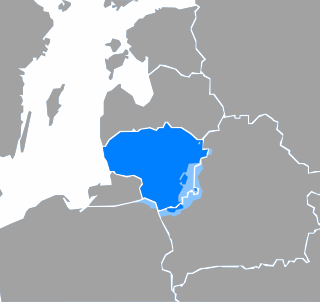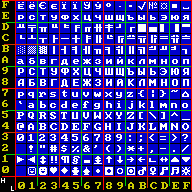Related Research Articles

Lithuanian is an East Baltic language belonging to the Baltic branch of the Indo-European language family. It is the language of Lithuanians and the official language of Lithuania as well as one of the official languages of the European Union. There are approximately 2.8 million native Lithuanian speakers in Lithuania and about 1 million speakers elsewhere. Around half a million inhabitants of Lithuania of non-Lithuanian background speak Lithuanian daily as a second language.

Code page 866 is a code page used under DOS and OS/2 in Russia to write Cyrillic script. It is based on the "alternative code page" developed in 1984 in IHNA AS USSR and published in 1986 by a research group at the Academy of Science of the USSR. The code page was widely used during the DOS era because it preserves all of the pseudographic symbols of code page 437 and maintains alphabetic order of Cyrillic letters. Initially this encoding was only available in the Russian version of MS-DOS 4.01 (1990), but with MS-DOS 6.22 it became available in any language version.
Windows-1257 is an 8-bit, single-byte extended ASCII code page used to support the Estonian, Latvian and Lithuanian languages under Microsoft Windows. In Lithuania, it is standardised as LST 1590-3, alongside a modified variant named LST 1590-4.
Mac OS Central European is a character encoding used on Apple Macintosh computers to represent texts in Central European and Southeastern European languages that use the Latin script. This encoding is also known as Code Page 10029. IBM assigns code page/CCSID 1282 to this encoding. This codepage contains diacritical letters that ISO 8859-2 does not have, and vice versa.
Code page 865 is a code page used under DOS in Denmark and Norway to write Nordic languages.

Code page 737 is a code page used under DOS to write the Greek language. It was much more popular than code page 869 although it lacks the letters ΐ and ΰ.
Code page 861 is a code page used under DOS in Iceland to write the Icelandic language.
Code page 775 is a code page used under DOS to write the Estonian, Lithuanian and Latvian languages. In Lithuania, this code page is standardised as LST 1590-1, alongside the related Code page 778.

The ZX Spectrum character set is the variant of ASCII used in the ZX Spectrum family computers. It is based on ASCII-1967 but the characters ^, ` and DEL are replaced with ↑, £ and ©. It also differs in its use of the C0 control codes other than the common BS and CR, and it makes use of the 128 high-bit characters beyond the ASCII range. The ZX Spectrum's main set of printable characters and system font are also used by the Jupiter Ace computer.
Code page 851 is a code page used under DOS to write Greek language although it lacks the letters Ϊ and Ϋ. It covers the German language as well. It also covers some accented letters of the French language, but it lacks most of the accented capital letters required for French. It is also called MS-DOS Greek 1.
Code page 773 is a code page used under DOS to write the Estonian, Lithuanian and Latvian languages.
Code page 912 is a code page used under IBM AIX and DOS to write the Albanian, Bosnian, Croatian, Czech, English, German, Hungarian, Polish, Romanian, Serbian, Slovak, and Slovene languages. It is an extension of ISO/IEC 8859-2, though prior to 1999, the code page matched ISO/IEC 8859-2 exactly.
Code page 1118 is a code page used under DOS to write the Lithuanian language. It was previously standardised in Lithuania as LST 1283.
Code page 1117 is a code page used under DOS to write the Estonian, Lithuanian and Latvian languages. It is closely related to both code page 773 and code page 775.
Code page 776 is a code page used under DOS to write the Lithuanian language. It is a modification of Code page 770 to support the accented Lithuanian letters and phonetic symbols for Lithuanian.
Code page 777 is a code page used under DOS to write the Lithuanian language. It is a modification of Code page 773 to support the accented Lithuanian letters and phonetic symbols for Lithuanian.
Code page 778 is a code page used under DOS to write the Lithuanian language. It is a modification of code page 775 to support the accented Lithuanian letters and phonetic symbols for Lithuanian. This code page is also known as LST 1590-2.
Code page 3846 is a modification of code page 437 to support the Turkish language. This code page is supported by Star printers and FreeDOS.
LST 1590-4 is a character encoding used to write the Lithuanian language. It is a modification of Windows-1257 to support additional accented letters and phonetic notation. This is called Code page 58601 by FreeDOS.
References
- ↑ "Codepages: Comprehensive list". Archived from the original on 2019-08-17. Retrieved 2019-08-24.
- ↑ "Rašmenų koduotės". Lietuvių kalba informacinėse technologijose (in Lithuanian). Archived from the original on 2019-08-28. Retrieved 2024-11-20.
- ↑ "770 kodų lentelė". Lietuvių kalba informacinėse technologijose – Rašmenų koduotės (in Lithuanian). Retrieved 2024-11-20.